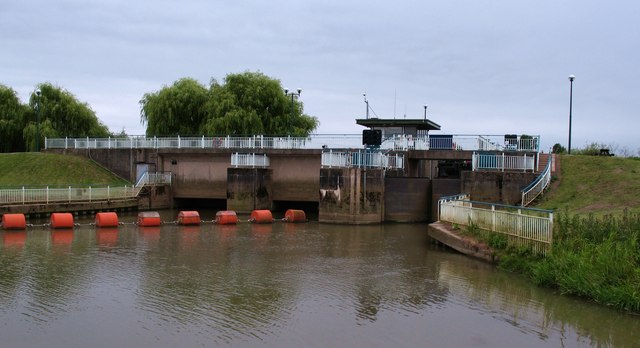Barrage
|
The Barmby tidal barrage is shown at the point where the Derwent meets the Ouse. The barrage was constructed in 1974 to prevent tidal water entering the Derwent and causing flooding. |
Contents |
[edit] Introduction
The International Levee Handbook, published by CIRIA in 2013, defines barrage as a: "Structure built in an estuary with the specific intention of preventing, or in some way modifying, tidal propagation.”
[edit] Types of barrages
[edit] Tidal barrage
A barrage may also be referred to as an estuary barrier or coastal barrier. It may be constructed to assist with irrigation or it can generate hydroelectricity by harnessing tidal power. These types of barrages may be referred to as tidal barrages.
[edit] Barrage dam
Barrages that are used as diversion dams (sometimes referred to as barrage dams) may be controlled by gates that are opened or closed in order to control water levels. The gates are constructed between piers that are used to control the load and pressure of the contained water.
Barrage dams are frequently constructed near the mouth of large, winding rivers. They are generally built on flat terrain.
Barrage dams primarily divert water and tend to raise water levels by relatively small amounts (such as one metre). Unlike conventional dams, they do not hold large amounts of water in reservoirs.
[edit] Related articles on Designing Buildings Wiki
Featured articles and news
The UK's Modern Industrial Strategy: A 10 year plan
Previous consultation criticism, current key elements and general support with some persisting reservations.
Building Safety Regulator reforms
New roles, new staff and a new fast track service pave the way for a single construction regulator.
Architectural Technologist CPDs and Communications
CIAT CPD… and how you can do it!
Cooling centres and cool spaces
Managing extreme heat in cities by directing the public to places for heat stress relief and water sources.
Winter gardens: A brief history and warm variations
Extending the season with glass in different forms and terms.
Restoring Great Yarmouth's Winter Gardens
Transforming one of the least sustainable constructions imaginable.
Construction Skills Mission Board launch sector drive
Newly formed government and industry collaboration set strategy for recruiting an additional 100,000 construction workers a year.
New Architects Code comes into effect in September 2025
ARB Architects Code of Conduct and Practice available with ongoing consultation regarding guidance.
Welsh Skills Body (Medr) launches ambitious plan
The new skills body brings together funding and regulation of tertiary education and research for the devolved nation.
Paul Gandy FCIOB announced as next CIOB President
Former Tilbury Douglas CEO takes helm.
UK Infrastructure: A 10 Year Strategy. In brief with reactions
With the National Infrastructure and Service Transformation Authority (NISTA).
Ebenezer Howard: inventor of the garden city. Book review.
The Grenfell Tower fire, eight years on
A time to pause and reflect as Dubai tower block fire reported just before anniversary.
Airtightness Topic Guide BSRIA TG 27/2025
Explaining the basics of airtightness, what it is, why it's important, when it's required and how it's carried out.
Construction contract awards hit lowest point of 2025
Plummeting for second consecutive month, intensifying concerns for housing and infrastructure goals.
Understanding Mental Health in the Built Environment 2025
Examining the state of mental health in construction, shedding light on levels of stress, anxiety and depression.
The benefits of engaging with insulation manufacturers
When considering ground floor constructions.
Lighting Industry endorses Blueprint for Electrification
The Lighting Industry Association fully supports the ECA Blueprint as a timely, urgent call to action.
























